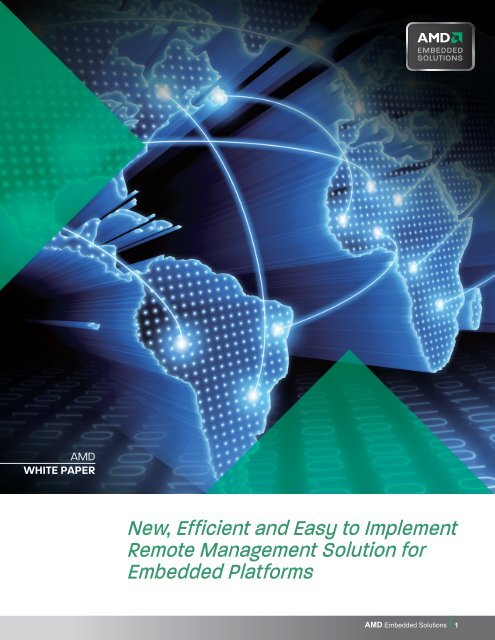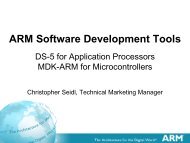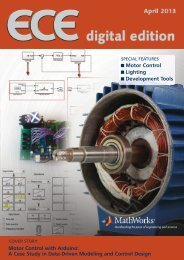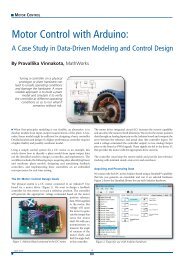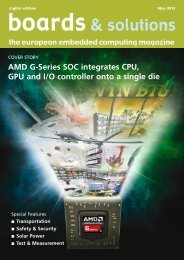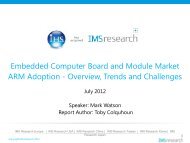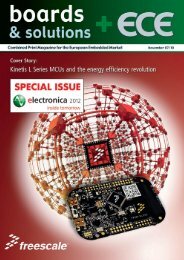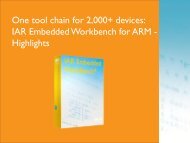New, Efficient and Easy to Implement Remote Management ... - AMD
New, Efficient and Easy to Implement Remote Management ... - AMD
New, Efficient and Easy to Implement Remote Management ... - AMD
- No tags were found...
You also want an ePaper? Increase the reach of your titles
YUMPU automatically turns print PDFs into web optimized ePapers that Google loves.
<strong>AMD</strong><br />
WHITE PAPER<br />
<strong>New</strong>, <strong>Efficient</strong> <strong>and</strong> <strong>Easy</strong> <strong>to</strong> <strong>Implement</strong><br />
<strong>Remote</strong> <strong>Management</strong> Solution for<br />
Embedded Platforms<br />
<strong>AMD</strong> Embedded Solutions 1
<strong>AMD</strong> WHITE PAPER<br />
<strong>Remote</strong> <strong>Management</strong> Solution for Embedded Platforms<br />
<strong>Remote</strong>ly accessing enterprise servers <strong>and</strong> office computers for system health moni<strong>to</strong>ring <strong>and</strong><br />
maintenance has been a critical function within the IT <strong>to</strong>olbox for many years. But those same<br />
capabilities have largely eluded the embedded systems market because of the high cost of existing<br />
solutions <strong>and</strong> implementing them is considered overly resource intensive in both cost <strong>and</strong> time.<br />
The “gold st<strong>and</strong>ard” for remote systems management is a set of specifications known as the Digital<br />
<strong>and</strong> Mobile Architecture for System Hardware (DASH). DASH is very robust – an attribute that makes it<br />
appealing for enterprise computing infrastructure. However, existing implementations are over designed<br />
<strong>and</strong> therefore <strong>to</strong>o costly for embedded systems applications, slowing down the adoption of DASH for<br />
most embedded applications.<br />
Now, <strong>AMD</strong> – a longtime member of the industry task force that birthed DASH – has created an<br />
implementation of DASH specifically for embedded platforms that removes the bloat of the costly<br />
implementations while retaining the essentials of a compliant DASH implementation.<br />
About DASH<br />
DASH was created through the efforts of dozens of companies in the IT industry who came <strong>to</strong>gether<br />
<strong>to</strong> collaborate on the development, validation <strong>and</strong> promotion of systems management st<strong>and</strong>ards.<br />
Their group, the Distributed <strong>Management</strong> Task Force, Inc. (DMTF), creates st<strong>and</strong>ards that enable<br />
interoperable IT management. As part of its work, the DMTF has developed open st<strong>and</strong>ards<br />
specifications <strong>to</strong> allow for the different platform management parts <strong>to</strong> interoperate; DASH is one element.<br />
Companies use DASH for systems moni<strong>to</strong>ring, asset management, <strong>and</strong> easing the deployment of<br />
software upgrades <strong>and</strong> patches, among other benefits. Because it is built around open st<strong>and</strong>ards, DASH<br />
helps lower <strong>to</strong>tal cost of ownership. But it also typically increases the cost of individual systems because<br />
of the additional components required <strong>to</strong> support platform management. Some of these additional costs<br />
– beyond the cost of developing the DASH implementation itself – include temperature sensors, a<br />
microcontroller for remote control support, <strong>and</strong> the DASH-compliant Ethernet controller.<br />
The Embedded L<strong>and</strong>scape<br />
Embedded systems differ from servers <strong>and</strong> PCs in that they are likely <strong>to</strong> be single purposed. For<br />
example, a digital signage deployment is single purposed but still requires regular software <strong>and</strong> security<br />
updates. With a large deployment such as a chain s<strong>to</strong>re, the systems easily could be scattered over a<br />
wide area. There is no ‘user’ <strong>and</strong> the security concerns differ from those of servers <strong>and</strong> PCs.<br />
Service <strong>and</strong> maintenance can be a substantial cost associated with embedded systems once they are<br />
deployed, <strong>and</strong> this is especially true if the systems are spread out across a broad geographic area. A<br />
primary goal for remote management is <strong>to</strong> dramatically reduce those costs. Systems can fail for a variety<br />
of reasons: software crashes, components overheat, power failures, or failed components. With remote<br />
management implemented on the deployed systems, systems that have gone down can potentially be<br />
<strong>AMD</strong> Embedded Solutions 2
<strong>AMD</strong> WHITE PAPER<br />
<strong>Remote</strong> <strong>Management</strong> Solution for Embedded Platforms<br />
repaired <strong>and</strong> rebooted remotely, without the need <strong>to</strong> have a service technician on site. If the software<br />
crashes, the system can be res<strong>to</strong>red <strong>and</strong> rebooted from a remote location, such as a management<br />
console.<br />
While other solutions for remote platform management already exist, a low-cost <strong>and</strong> easy <strong>to</strong> implement<br />
remote management solution has not been available, until now.<br />
Out-of-b<strong>and</strong> vs. in-b<strong>and</strong> remote management<br />
<strong>Remote</strong> management implementations generally consist of both in-b<strong>and</strong> <strong>and</strong> out-of-b<strong>and</strong> functionality.<br />
Out-of-b<strong>and</strong> functions are defined as those that can be exercised while the target system is not powered<br />
on, or the operating system is not functioning. In-b<strong>and</strong> remote management leverages software running<br />
on the installed operating system <strong>to</strong> communicate with the remote console <strong>and</strong> perform functions on<br />
the target system. This <strong>AMD</strong> DASH implementation targets a cost effective solution that has been fully<br />
tested <strong>to</strong> help ensure interoperability of the hardware <strong>and</strong> software solution for out-of-b<strong>and</strong> functions.<br />
The implemented out-of-b<strong>and</strong> functions are intended <strong>to</strong> provide the essential support needed <strong>to</strong> help<br />
reduce service <strong>and</strong> maintenance costs. There are many st<strong>and</strong>ard solutions available on the market <strong>to</strong><br />
support in-b<strong>and</strong> remote management independent of this implementation.<br />
DASH <strong>Implement</strong>ation for Embedded Applications<br />
<strong>AMD</strong> created a combined software <strong>and</strong> hardware reference design demonstrating an implementation<br />
of DASH supporting just the essential functions. This implementation is targeted <strong>to</strong> help our embedded<br />
cus<strong>to</strong>mers who wanted the benefits DASH affords, without investing the extensive cost <strong>and</strong> resources it<br />
might take <strong>to</strong> develop their own implementations. <strong>AMD</strong> started by studying the full DASH specification <strong>to</strong><br />
identify the elements that are important <strong>to</strong> <strong>and</strong> most beneficial for embedded applications. The resulting<br />
DASH implementation for embedded solutions is ideal for:<br />
systems without a keyboard <strong>and</strong> mouse<br />
systems connected <strong>to</strong> the Internet or a network<br />
systems deployed in locations where service personnel have no immediate <strong>and</strong>/or direct<br />
access <strong>to</strong> the system.<br />
▲ ▲ ▲<br />
By creating an actual implementation that developers can use “as is” or modify for their own<br />
needs – rather than another specification – the <strong>AMD</strong> Embedded Solutions group is making DASH<br />
implementations easier <strong>to</strong> create. This implementation offers many of the key capabilities of DASH but<br />
helps reduce or eliminate development costs, <strong>and</strong> the cost associated with unnecessary components<br />
found in larger implementations. When coupling this implementation with a DASH-compliant Ethernet<br />
controller, companies can obtain a low-cost, yet effective platform management solution for all of their<br />
networked embedded systems.<br />
<strong>AMD</strong> Embedded Solutions 3
<strong>AMD</strong> WHITE PAPER<br />
<strong>Remote</strong> <strong>Management</strong> Solution for Embedded Platforms<br />
PCIe<br />
DASH<br />
Compliant<br />
NIC 1<br />
LAN<br />
<strong>Management</strong><br />
Console 2<br />
SMBUS/I 2 C<br />
SB_TSI<br />
Temperature<br />
<strong>AMD</strong> APU<br />
<strong>Remote</strong> Control<br />
Controller<br />
NXP Semi - P89LPC915<br />
SMBUS-1<br />
Controller<br />
Hub<br />
TEMP<br />
Sensor<br />
NXP Semi<br />
SA56004<br />
Out of B<strong>and</strong> Comm<strong>and</strong>s<br />
1. Reset<br />
2. Power-UP<br />
3. Unconditional Power-Down<br />
4. Power Cycle Reset<br />
System Reset<br />
Power But<strong>to</strong>n<br />
System Alert LED<br />
FANIN<br />
FANOUT<br />
Fan Moni<strong>to</strong>ring<br />
1. FANOUT – Is fan on<br />
2. FANIN – If fan is on is it working<br />
DASH <strong>Implement</strong>ation for Embedded Applications<br />
1.The DASH compliant NIC may be selected based on component vendor preference for the board design. <strong>AMD</strong><br />
performed testing using a Realtek NIC.<br />
2.The remote management console is selected based on preference for the deployment. The Microsoft solution is<br />
Windows <strong>Remote</strong> <strong>Management</strong>.<br />
The <strong>AMD</strong> implementation includes the following essential DASH functions:<br />
<strong>Remote</strong> power control - allows remote power-on, power-off, power-cycle, or reset of the<br />
system<br />
Boot control - directs the system <strong>to</strong> reboot <strong>to</strong> specified boot device (e.g., PXE, floppy, remote<br />
media) The key use cases include:<br />
remote boot <strong>to</strong> a deployment OS (such as Windows PE) for system provisioning<br />
remote boot <strong>to</strong> a network CD image <strong>to</strong> update BIOS or firmware or <strong>to</strong> run diagnostics<br />
Platform alerts - a console can subscribe <strong>to</strong> alerts via a WS-eventing pro<strong>to</strong>col. Platform alerts<br />
may include temperature alerts, ProcHot, ThermTrip <strong>and</strong> fan failure,<br />
Hardware Asset inven<strong>to</strong>ry - platform model number, CPU version, BIOS version, memory <strong>and</strong><br />
other hardware info is available for specific implementation needs<br />
▲<br />
▲<br />
▲<br />
▲<br />
An essential part of any remote management implementation that is supported is the ability <strong>to</strong> reset,<br />
power-up, power-down or power cycle the system from a remote location. Additionally, if the BIOS<br />
requires an update, or a new operating system image must be installed, this can be accomplished<br />
by leveraging the supported boot control function. Together, these capabilities reduce unscheduled<br />
downtime <strong>and</strong> often eliminate the need of a technician <strong>to</strong> physically service the system.<br />
<strong>AMD</strong> Embedded Solutions 4
<strong>AMD</strong> WHITE PAPER<br />
<strong>Remote</strong> <strong>Management</strong> Solution for Embedded Platforms<br />
Not all service calls can be eliminated, however. Systems do fail. When that happens, a service call<br />
is inevitable. But some of these service calls can go from unscheduled emergency calls <strong>to</strong> scheduled<br />
service calls. For instance, devices often fail because they overheat – because a fan has failed. Since<br />
fans are mechanical, they rarely fail instantly but instead show signs of impending failure in advance.<br />
Through the support of platform alerts, fans can be moni<strong>to</strong>red <strong>and</strong> temperatures watched. So, rather<br />
than suffer a catastrophic failure due <strong>to</strong> overheating, fans can be replaced as soon as they begin <strong>to</strong><br />
show signs of impending failure.<br />
The DASH implementation in the reference design delivers the essential features in an easy <strong>to</strong><br />
implement solution targeted at embedded applications. Our embedded cus<strong>to</strong>mers can leverage this<br />
reference design <strong>to</strong> avoid starting their DASH implementations at the ground level.<br />
<strong>AMD</strong> embedded cus<strong>to</strong>mers interested in implementing this DASH solution can obtain the schematics,<br />
microcontroller source code <strong>and</strong> binary, <strong>and</strong> implementation guide for free. The only requirement is that<br />
it be used in an <strong>AMD</strong>-based solution. Please visit the <strong>AMD</strong> Embedded Developers Web site <strong>to</strong> download<br />
the full reference design.<br />
Summary<br />
<strong>Remote</strong> systems management is as important for embedded applications as it is for PCs <strong>and</strong> servers.<br />
But until now, it <strong>to</strong>ok a lot of time <strong>to</strong> develop a solution that was often more expensive than it needed <strong>to</strong><br />
be for embedded applications. <strong>AMD</strong> has developed a DASH reference design targeted at the essential<br />
functions needed for embedded applications. The reference design will help <strong>AMD</strong> cus<strong>to</strong>mers <strong>to</strong> quickly<br />
implement a cost effective DASH solution. The reference design is free <strong>and</strong> available <strong>to</strong> <strong>AMD</strong> cus<strong>to</strong>mers<br />
now.<br />
About <strong>AMD</strong><br />
<strong>AMD</strong> is a semiconduc<strong>to</strong>r design innova<strong>to</strong>r leading the next era of vivid digital experiences with its<br />
groundbreaking <strong>AMD</strong> Accelerated Processing Units (APUs) that power a wide range of computing<br />
devices. <strong>AMD</strong> Embedded Solutions give designers ample flexibility <strong>to</strong> design scalable, x86-based, lowcost<br />
<strong>and</strong> feature-rich products, <strong>and</strong> drive energy conservation in<strong>to</strong> their systems without compromising<br />
application performance or compatibility, graphics performance, or features. For more information, visit<br />
http://www.amd.com/embedded.<br />
©2012 <strong>AMD</strong>, the <strong>AMD</strong> Arrow logo <strong>and</strong> combinations thereof, are trademarks of Advanced Micro Devices.<br />
Windows is a registered trademark of Microsoft Corporation in the U.S. <strong>and</strong>/or other jurisdictions. PCIe<br />
<strong>and</strong> PCI Express are registered trademarks of PCI-SIG. Other names are for informational purposes<br />
only <strong>and</strong> may be trademarks of their respective owners.<br />
<strong>AMD</strong> Embedded Solutions 5


